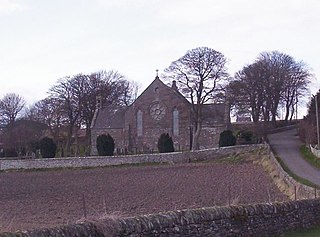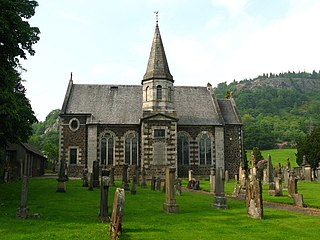Gilbert Garden (also known as Gardin or Gardyn) was a 16th-century Church of Scotland minister immediately after the Reformation, who served as Moderator of the General Assembly in August 1571.
Gilbert Garden (also known as Gardin or Gardyn) was a 16th-century Church of Scotland minister immediately after the Reformation, who served as Moderator of the General Assembly in August 1571.

He was born and/or raised in Boath near Carmyllie in Forfarshire. [1]
From 1563 to 1565 he was minister of Monikie. [2]
In 1565 he became minister of Monifieth. In July 1568 he was presented by King James VI to the congregation of Fordyce, the principal Presbytery of the area, and translated as minister of the parish church in February 1569. [1]
In August 1571 he succeeded George Hay as Moderator of the General Assembly of the Church of Scotland the highest position in the Scottish church. This Assembly met in Stirling. [3]
In 1595 he translated to Cullen for a year before returning to Fordyce. As his position at Fordyce was filled by Patrick Darg in 1599 Garden must be presumed dead in or before 1599. [1]
His wife Margaret died in April 1592 aged 66 and is buried in Fordyce; [2] in August 1592 he married Isobel Strachan of Carmyllie (west of Arbroath).

Ceres is a village in Fife, Scotland, located in a small glen approximately 2 miles (3 km) over the Ceres Moor from Cupar and 7 mi (11 km) from St Andrews. The former parish of that name included the settlements of Baldinnie, Chance Inn, Craigrothie, Pitscottie and Tarvit Mill.
Alexander Hume was a Scottish poet who served as Moderator of the General Assembly of the Church of Scotland in the early 17th century.
John Willock was a Scottish reformer. He appears to have been a friar of the Franciscan House at Ayr. Having joined the party of reform before 1541, he fled for his life to England. There he became noted as a zealous and taking preacher. This led to his arrest for heresy under an Act of Henry VIII., "for abolishing diversity of opinion" in matters of religion. He was found guilty of preaching against purgatory, holy water, priestly confession, and prayer to the saints, and of holding that priests might lawfully be married, he was for some time confined in the Fleet prison. After the accession of Edward VI he was chaplain to Henry, Duke of Suffolk, who had married King Henry's niece, and is best known as the father of Lady Jane Grey. He preached for a time in London, in St Katherine's Church, when both he and John Knox, his fast friend, were granted general license to preach anywhere in England. Henry, Earl of Huntingdon, presented him to the rectory of Loughborough in Leicestershire, a living which he continued to hold during King Edward's reign, and again during that of Queen Elizabeth for the rest of his life. Thus in his later years he was in the unique position of being at the same time a parish minister in both England and Scotland. When Mary Tudor came to the English throne in 1553, Willock fled to Embden, in the Protestant Duchy of Friesland. There he practised as a physician with much success, and rose to some eminence. In 1555, and again in 1556, the Duchess Anne of Friesland sent him to Scotland as her Commissioner on matters of trade. In 1558 he returned home, and preached for some time in Dundee, with much acceptance among the friends of reform. In 1559, when John Knox had to leave Edinburgh in peril of his life, Willook took his place as the evangelist of the Reformation. It was then that he conducted in St Giles what is believed to have been the earliest public celebration of the Holy Communion in Scotland after the reformed ritual. In 1560, when Queen Mary of Guise lay dying, the Earls of Argyll and Moray, and other Lords of the Congregation advised her to "send for a godly, learned man of whom she might receive instruction"; and Willock was chosen to minister to her, which he faithfully did. That same year he was made Superintendent of Glasgow and the West. He was also one of the six Johns entrusted with the drawing up of the First Book of Discipline, the others being John Knox, John Winram, John Spottiswood, John Douglas, and John Row. Sometime in that year he went to England, and brought home his wife, Katherine Picknavell, an English lady. He was chosen Moderator of the General Assembly in 1563, 1564, 1565, and 1568. In 1565 Queen Mary endeavoured to put a stop to his activity by having him imprisoned in Dumbarton Castle; but the Reformers were now too strong for her, and she had to depart from her purpose.

Robert Pont (1529–1606) was a Church of Scotland minister, judge and reformer. He was a church minister and commissioner and a Senator of the College of Justice.
James Nicolson (1557–1607) was Bishop of Dunkeld in 1607.

Carmyllie is a rural parish in Angus, Scotland. It is situated on high ground between Arbroath, on the coast, and the inland county town of Forfar. The main settlements in the parish are Redford, Greystone, Guynd and Milton of Carmyllie. There is a Church of Scotland church and a primary school. The Elliot Water rises in the west of the parish.
John Duncanson was a Scottish minister, one of the Roman Catholic clergymen who willingly converted to the Protestant doctrines at the Reformation. He was reputed to have lived to be nearly 100 years old. He was as the President of St Leonard's College, St Andrews in 1556, around the time that he accepted the reformed faith. He held this position until 1566. He was the minister at Stirling in 1560.

Trinity College Kirk was a royal collegiate church in Edinburgh, Scotland. The kirk and its adjacent almshouse, Trinity Hospital, were founded in 1460 by Mary of Gueldres in memory of her husband, King James II who had been killed at the siege of Roxburgh Castle that year. Queen Mary was interred in the church, until her coffin was moved to Holyrood Abbey in 1848.
Patrick Galloway was a Scottish minister, a Moderator of the General Assembly of the Church of Scotland. He was Moderator of the General Assembly in 1590, and again in 1602. Having been completely gained over by the Court party he used all his influence in forwarding the views of the King for the introduction of Episcopacy.
Andrew David Keltie Arnott is a retired minister of the Church of Scotland who was the Moderator of the General Assembly of the Church of Scotland from 2011 to 2012.
Robert Small FRSE (1732–1808) was a Scottish minister who served as Moderator of the General Assembly of the Church of Scotland in 1791. He was keenly interested in mathematics and astronomy and was a founder member of the Royal Society of Edinburgh, to whose Transactions he contributed a paper proving some theorems in geometry. He was Minister of the first charge in the Parish of Dundee, and used his mathematical abilities to compile, in 1792, an exemplary Report on his Parish for the First Statistical Account of Scotland. In 1804 he published an explanation of Kepler's laws of planetary motion. He was very active in social improvements in his parish, organising a subscription for Voluntary Dispensary, and Surgery, which eventually became Dundee Royal Infirmary.

Logie Kirk is an isolated but operational church east of Stirling in central Scotland serving Church of Scotland pastoral duties in the areas of Cambuskenneth, Bridge of Allan, Causewayhead, and formerly the estate of Airthrey Castle.
William Mitchell (1670–1727) was a 17th/18th century Scottish minister who served as Moderator of the General Assembly of the Church of Scotland five times. He was Chaplain in Ordinary to the King.
Thomas Buchanan was a Church of Scotland minister who served as Moderator of the General Assembly in 1588.
Robert Hamilton (c.1530–1581) was a Church of Scotland minister who served as Moderator of the General Assembly in 1572 and was Principal of New College in St Andrews.
George Hay (c.1530–1588) was a Church of Scotland minister immediately after the Reformation, who served as Moderator of the General Assembly from March 1571.
William Christison (c.1520–1603) was a Church of Scotland minister immediately after the Reformation, who served as Moderator of the General Assembly in July 1569.
Andrew Hay of Renfield (c.1540–1593) was a Scottish minister who served twice as Moderator of the General Assembly of the Church of Scotland in both 1573/4 and 1580/1. From 1569 to 1586 he was also Rector of the University of Glasgow.

John Smith (1854–1927) was a Scottish minister who served as Moderator of the General Assembly of the Church of Scotland in 1922 and was also heavily involved in Scottish education including Chairman of Govan School Board.